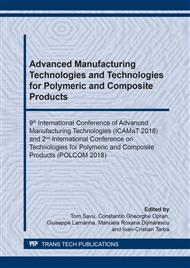[1]
B. Haynes, J. Power Sources 92 (2001) 199-203.
Google Scholar
[2]
S.E. Wright, J. Renew. Energy 28 (2004) 179-195.
Google Scholar
[3]
I. Maior, A. Cojocaru, Principles and Applications of Conversion and Electrochemical Storage of Energy, Electra Publishing House, Bucharest, (2011).
Google Scholar
[4]
Y. Wang, K.S. Chen, J. Mishler, S.C. Cho, X.C. Adroher, A Review of Polymer Electrolyte Membrane Fuel Cells: Technology, Applications, and Needs on Fundamental Research, Elsevier, USA, (2010).
DOI: 10.1016/j.apenergy.2010.09.030
Google Scholar
[5]
F. Croce, G.B. Appetecchi, L. Perci, S. Scrosati, Natur 394 (1998) 456–461.
Google Scholar
[6]
J.E. Weston, B.C.H. Steele, Solid State Ionics 7 (1982) 75–82.
Google Scholar
[7]
Y. Chang, Y. Qin, Y. Yin, J. Zhang, X. Li, Appl. Energy 230 (2018) 643–662.
Google Scholar
[8]
J.K. Deuk, J.J. Min, Y.N. Song, J. Ind. Eng. Chem. 21 (2015) 36-52.
Google Scholar
[9]
Q.X. Wu, T.S. Zhao, R. Chen, L. An, Appl. Energy 106 (2013) 301-306.
Google Scholar
[10]
I.L. Alsvik, K.R. Zodrow, M. Elimelech, M.B. Hägg, Desalination 312 (2013) 2-9.
Google Scholar
[11]
N. Gospodinova, L. Terlemezyan, Prog. Polym. Sci 23 (1989) 1443-1484.
Google Scholar
[12]
Y. Cao, A. Andreatta, A.J. Heeger, P. Smith, Polymer 30 (1989) 2305-2311.
Google Scholar
[13]
D.K. Moon, A.B. Padias, H.K. Hall, T. Huntoon, P.D. Calvert, Macromolecules 28 (1995) 6205-6210.
Google Scholar
[14]
A.G. MacDiarmid, A.J. Epstein, Synth. Met. 65 (1994) 103-116.
Google Scholar
[15]
S.A. Chen, H.T. Lee, Macromolecules 28 (1995) 2858-2866.
Google Scholar
[16]
Y. Cao, P. Smith, A.J. Heeger, Synth. Met. 32 (1989) 263-281.
Google Scholar
[17]
H. Tsutsumi, S. Fukuzawa, M. Ishikawa, M, Morita, Y. Matsuda, J. Electrochem. Soc. 142 (1995) 168-170.
Google Scholar
[18]
F. Croce, R. Curini, A. Martinelli, F. Ronci, B. Scrosati, R. Caminiti, J. Phys. Chem. 103 (1999) 10632–10639.
DOI: 10.1021/jp992307u
Google Scholar
[19]
G.M. Wa, S.J. Lin, C.C. Yang, J. Membr. Sci. 275 (2006) 127-133.
Google Scholar
[20]
M. Kamran, H. Ullah, A.A. Shah, S. Bilal, A.A. Tahir, K. Ayub, Polymer 72 (2015) 30-39.
Google Scholar
[21]
P. Choi, N.H. Jalani, R. Datta, J. Electrochem. Soc. 152 (2005) 123-130.
Google Scholar
[22]
A.M. Albu, I. Maior, C.A. Nicolae, F.L. Bocăneală, Electrochim. Acta 211 (2016) 911–917.
Google Scholar
[23]
I. Maior, A.M. Albu, R. Gabor, Appl. Mechanics and Mat. 760 Advanced Technologies in Designing and Progressive Development of Manufacturing Systems, (2015) 245 – 250.
Google Scholar
[24]
Z. Ping, J. Chem. Soc. Faraday Trans. 92 (1996) 3063-3067.
Google Scholar
[25]
M. Trchova, I. Sedenkova, J. Stejskal, Synth. Met. 154 (2005) 1-4.
Google Scholar
[26]
J. Stejskal, R.G. Gilbert, Pure Appl. Chem. 74 (2002) 857-867.
Google Scholar
[27]
S. Quillard, G. Louarn, J.P. Buisson, M. Boyer, M. Lapkowski, A. Pron, et al., Synth. Met. 84 (1997) 805-806.
DOI: 10.1016/s0379-6779(96)04155-0
Google Scholar
[28]
Y. Dai, Y. Wang, S.G. Greenbaum, S.A. Bajue, D. Golodnitsky, G. Ardel, et al., Electrochim. Acta 43 (1998) 1557–1563.
Google Scholar
[29]
X. Xu, Y-Q Yang, Y-Y Xing, J-F Yang, S-F Wang, Carbohydr Polym. 98 (2013) 1573-1577.
Google Scholar
[30]
T.D.O. Gadim, F.J.A. Loureiro, C. Vilela, N. Rosero-Navarro, A.J.D. Silvestre, C.S.R. Freire, F.M.L. Figueiredo, Electrochim. Acta 233 (2017) 52–61.
DOI: 10.1016/j.electacta.2017.02.145
Google Scholar
[31]
W. Vermerris, A. Abril, Curr. Opin. Biotechnol. 32 (2015) 104-112.
Google Scholar
[32]
F. Colò, F. Bella, J.R. Nair, M. Destro, C. Gerbaldi, Electrochim. Acta 174 (2015) 185-190.
DOI: 10.1016/j.electacta.2015.05.178
Google Scholar
[33]
D.J. Kim, M.J. Jo, S.Y. Nam, J. Ind. and Eng. Chem. 21 (2015) 36-52.
Google Scholar
[34]
N. Awang, A.F. Ismail, J. Jaafar, T. Matsuura, H. Junoh, M.H.D. Othman, M.A. Rahman, React. Funct. Polym. 86 (2015) 248-258.
Google Scholar


